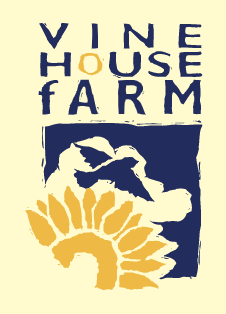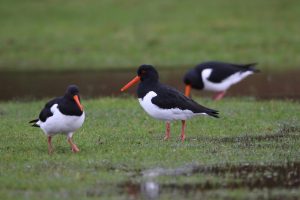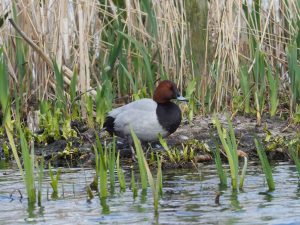
With a Miserable March and now miserable April, we have certainly had our fair share of April showers, with 49mm of rain – the average has been 39.7mm over the last 50 years. Several people have been saying to me ‘Oh I wish it would warm up’, but April has actually been warmer than usual, with an average temperature of 9.2°C. It shows how memories fade, only two years ago we had the coldest April for 100 years and nobody seems to remember it. The average temperature for April 2021 was only 5.95°C with 13 air frosts that month!

The miserable March did not let us get any spring drilling done but the crops drilled in February are well up and away. They will be putting roots down into the subsoil and therefore will be more able to withstand a summer drought. It is only in the second half of April that we have been able to get our sugar beet and peas drilled. The first half of April was a continuation of the miserable March.
We have also been planting potatoes on our lighter land. We need another two weeks of dry weather to get all the potatoes in. We have just enough men to be drilling seeds, as well as planting potatoes, without calling me in to help! While the potatoes are being planted, we will be drilling the sunflowers and the millet in the next two weeks; there will be other jobs to do as well.
We’ve had to rip up one field of oil seed rape because the flea beetle ate so much of it. This makes it more susceptible to the frost, some of our neighbours have also had to rip up crops. We used to control the flea beetle by coating the seed with a neonicotinoid and it worked every time but as the neonicotinoid disorientates the bees, the chemical has been withdrawn. Extensive studying in laboratories was needed to prove this, which many people, including the National Farmers Union, disputed the findings. Eventually the result was accepted and the ban on using it on any crop that comes into flower, is complete here in the UK. As I have said before, scientists make the chemical bullets for us to fire and we have no idea what, if any, the consequences might be.
Two other fields are being hounded by the wood pigeons. They are eating so much of the seed/shoots, they are delaying them from coming in flower. Oil seed rape has been a really good standby for the last 40 years, but with all the troubles we are having with it, it’s not an easy crop to grow now. It is the best crop for wildlife, probably because it has the most flowers on it – more flowers mean more insects, and more insects mean more birds. In fact, more birds feed on it and nest in it than any other crop we grow. Linnets will also take a lot of unripe rape seeds to their young. The acreage of rape has declined over the past five years and so has the Linnet population here in Deeping Fen.
We are growing oats for the first time for several years. It was never a good crop to grow, but recently it has become a more popular crop as there is a demand for it, partly to make oat milk.


For most of us, it is the increased activity of the birds in our gardens that is always interesting at this time of year. Blackbirds and Robins have been feeding young for a few weeks now and by feeding them live mealworms, you can bring them right up to your windows and see the amusing things they get up to. Starlings have also been eating the live mealworms and April 29th was the first time I saw them taking a beak full of them away, to feed their young.
Starlings nest in safe places, usually in a hole in a tree or a building. The young don’t come out of the nest until they can fly properly. Robins and Blackbirds nests are in less safe places, and so their young must leave the nest before they can fly properly. They will scatter under nearby bushes and stay quietly waiting for their parents to feed them. If a cat or another predator should come round, they may only find one of the youngsters.
After a few days when they can fly properly the father will lead them away from his territory and feed them elsewhere. When they can feed themselves, he will go back and help his partner to bring up the next brood and that may well happen again as they usually have three broods, if the conditions are right. It isn’t quite so easy to observe this going on, as a Blackbird from a nearby garden might bring his young into your garden to feed them too. They may well get into trouble from your resident pair and then of course we see them having a fight because they are encroaching on someone else’s territory.
Starlings do have a territory around their nest, but they are prepared to feed together. They generally don’t have time for a lot of fighting; they are more committed to what they are doing. Whilst generally size matters when it comes to birds feeding, the smaller birds have to stand aside when a bigger bird comes into feed, Starlings will certainly push in front of Blackbirds to feed. It all makes what’s happening in your garden so interesting.
Spring migrants have been slow to arrive, not surprising really, as we’ve had several days of northerly winds. On April 24th, I visited the entrance to our reservoir to take a photo of cowslips. Standing in one spot, I heard a Chiff Chaff, a Willow Warbler, a Blackcap, a Sedge Warbler and a Whitethroat all singing. I went back the next day and also heard a Reed Warbler. Six species of warblers from the same spot, something you would have a job to hear even on a nature reserve.
Out on the open fields I have seen more Wheatears than usual this spring. They are a small bird related to a Robin, but a bit bigger. They nest in our uplands right up to the Arctic circle and beyond. Some even continue over the polar icecap and nest in Alaska, such an amazing journey for such a small bird. We have proof of this, because some of them have been fitted with a tracker. To find this information, the bird has to be caught a second time and the tracker removed. Isn’t wildlife amazing!
Cuckoos are arriving back, the first one I heard, and saw was on April 26th and I saw another two on April 28th.



